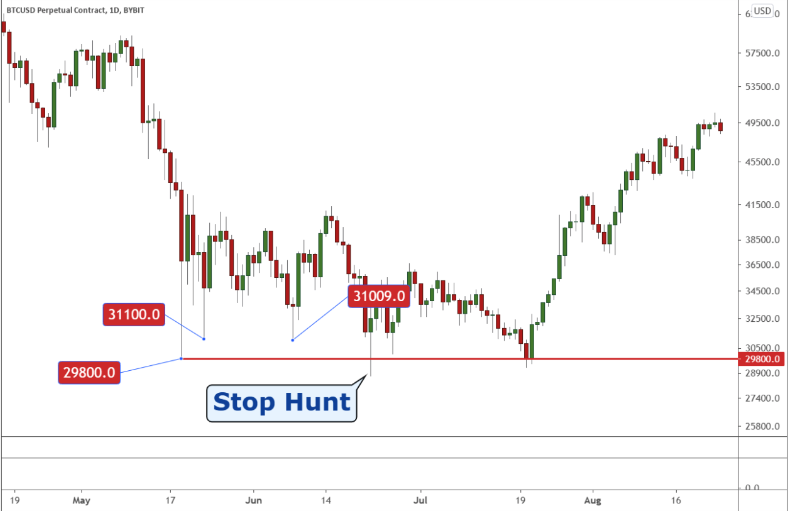Why you need to be aware of Stop Loss Hunting
28 October 2022
Stop loss hunting is frustrating, annoying and can be detrimental to any retail trader. The premise of stop hunting is that large systemised institutional trading strategies know where the average retail trader or most traders will set stop losses and therefore profit off triggering these ‘stops. Their own algorithm will then deliberately, trigger the stop losses. For traders there are few things as frustrating as have a well-positioned trade, being stopped out and then
What is a stop loss?
Understanding stop loss hunting requires a simple understanding of what a stop loss is. A stop loss is a trigger on traders’ position to close the position at a certain price. Generally, once triggered the position will attempt to be closed at the specified price. Stop losses provide an important role in risk management for many traders. Generally, traders use stops losses to avoid emotional mismanagement and better manage overall risk by having clear exit points for the trade in worst case scenarios.
The second element that is important to understand is where traders put their stop losses and why. Retail traders often place their stop losses near important market structures also known as support and resistance levels. These areas represent strong zones of supply and demand. When support and resistance zones become more and more consistent and more obvious, it can create a clump of stop losses. These stop losses can be thought of as orders that must get filled if the price reaches those points. This creates an attractive opportunity for large institutions with powerful algorithms that can push the price down and generate profits by ‘stopping out’ traders by triggering these stop losses. Once this process has occurred, the price will often move back in the direction the original trades were positioned for.
Why would a system want to trigger stop losses
Firstly, when stop losses are triggered, a price tends to see an increase in relative volatility. Therefore, it may indicate the beginning of a reversal which sophisticated traders profiting. It also allows these large institutions to maximise their own existing trades as it may allow for better entries.
Common areas for where stop hunters will look
Stop Loss hunting tends to be most active around significant and clear areas of support and resistance. This is especially true with regards to commonly traded assets. However, stop loss hunting can occur in all assets with various sizes. A stop hunt can be seen often with a small candlestick and a large wick. In addition, they often occur on very short time frames.
Common Area for Stop Loss Hunting
- At key moving average levels
- Clear Support and Resistance Levels
- Historical Support and Resistance Levels ie, Multiyear levels

How to deal with Stop Loss Hunting?
The obvious tactic to deal with stop hunting is to lower the stop loss below the obvious support and resistance level by a factor of maybe 10%. This may require smaller trade size, but overall will allow the trade to hopefully avoid these potential stop losses. Treat support and resistance as areas instead of specific price points. Support and resistance do not exist at one price and rather a range of prices that are supply and demand zones. Therefore, placing stop losses below these ‘zones’ may put the trade out of arm length of stop hunters. Simply being aware of stop loss hunting may provide some reassurance when a sharp spike in price occurs, to remain in the trade and not exit immediately.
Ultimately, Stop Loss Hunting is just another challenge that traders must deal with in the pursuit of profit. However, with some knowledge traders can adequately accommodate these tricky occurrences.
Disclaimer: Articles are from GO Markets analysts and contributors and are based on their independent analysis or personal experiences. Views, opinions or trading styles expressed are their own, and should not be taken as either representative of or shared by GO Markets. Advice, if any, is of a ‘general’ nature and not based on your personal objectives, financial situation or needs. Consider how appropriate the advice, if any, is to your objectives, financial situation and needs, before acting on the advice.
Next Article
Buying entry forming on EUR/NZD?
The EUR has been rebounding strongly on the back of being sold off for much of the year. With inflation at record highs and a cost of living and energy crisis, the currency has become extremely weak, even dropping below parity with the USD. However, in recent week, the EUR has begun putting in a bottom. The ECB last night decided to raise their off...
Previous Article
Boeing’s Q3 results have landed – the stock is down
The Boeing Company (NYSE:BA) announced Q3 earnings results before the market open in the US on Wednesday. The world’s largest aerospace company r...




